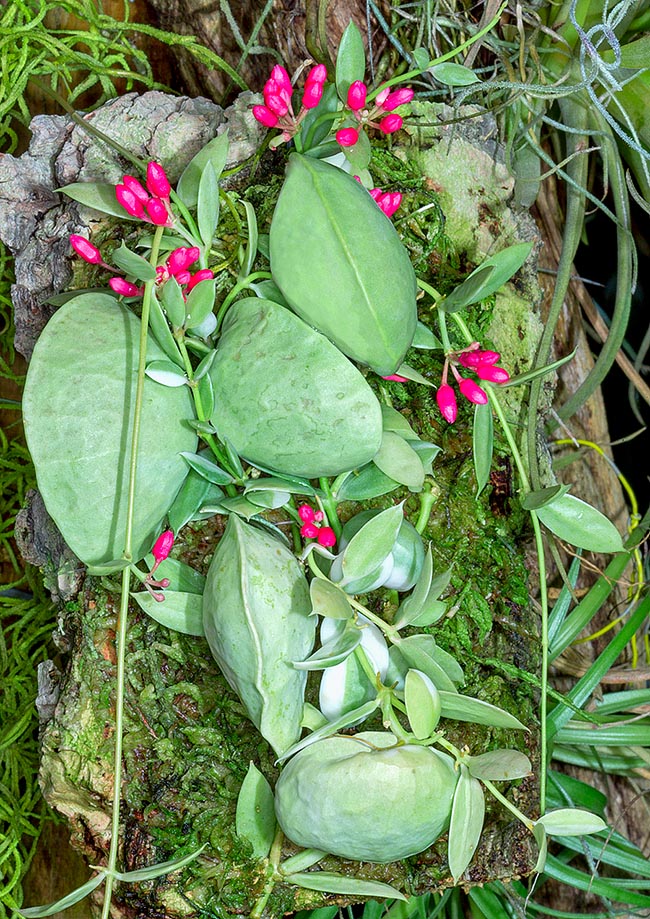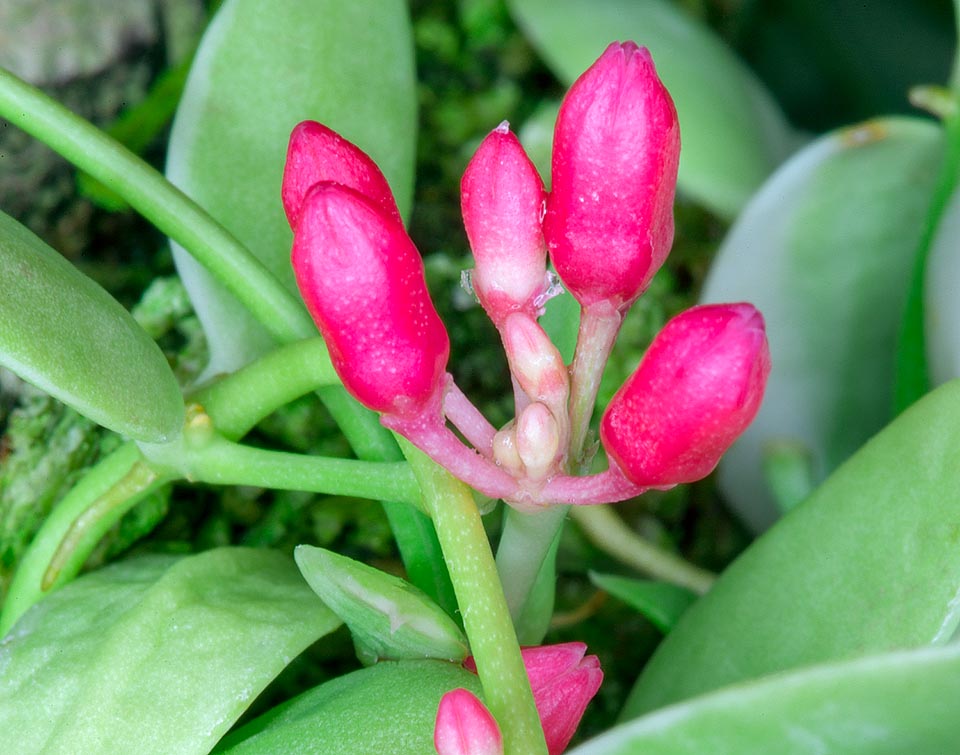Family : Apocynaceae

Text © Pietro Puccio

English translation by Mario Beltramini

Dischidia vidalii in flower with ascidia. It’s matter of modified leaves bigger than the normal ones, hollow inside and with an entry hole, to host colonies of small ants that in return offer a good fertilizer to the roots © Giuseppe Mazza
The species is native to Philippines (Luzon) where grows as epiphyte, usually on bamboos, at low altitude.
The name of the genus comes from the combination of the Greek adverb “δίς” (dis) = twice and of the verb “σχίζω” (schizo) = to separate, to divide, with reference to the bifid lobes of the staminal corona; the species is honoured to the Spanish botanist Sebastián Vidal y Soler (1842-1889).
Common names: ant plant, bladder vine, kangaroo pocket (English), plante escargot (French); dapo-sa-boho, dapong boho, lobo-lob (Tagalog); Schneckenhaus-Pflanze (German).
The Dischidia vidalii Becc. (1886) is an evergreen epiphyitic herbaceous species with thin stems having a milky sap, climbing or drooping, rooting at the nodes, up to about 3 m long. The leaves, on short petiole, are opposite, simple, ovate-elliptical to lanceolate with acute apex and entire margin, fleshy, 1,5-3 cm long and 0,8-1,3 cm broad, of pale green colour.
Ascidia (modified leaves forming a cavity connected to the outside through an opening), solitary at the nodes, subsessile, separated by some normal leaves, 4-7 cm long, 3,5-5 cm broad and about 2 cm thick, externally of the same colour as the leaves, brown red internally, that present a small orifice, of about 2 mm of diameter, at the bottom of an imbutiform depression in correspondence with the junction of the petiole. In the ascidium, that usually hosts a colony of small ants, do collect water, vegetal debris and organic residues, in particular of the ants, that act as fertilizer for the roots that develop from the petiole and ramify inside the same.
Axillar inflorescences, on a 1-2 cm long peduncle with few flowers, on an about 6 mm long pedicel, of red to magenta colour with urceolate corolla, 0,8 cm long, and corona with 5 lobes with bifid apex shaped like an anchor. The fruits are cylindrical follicles in pair with pointed apex, 5-7 cm long and of about 0,5 cm of diameter, containing numerous seeds, about 2 mm long, provided at one extremity of a tuft of silky hairs that favour their dispersion through the wind.
It reproduces by seed, placed superficially on porous and draining loam maintained humid at the temperature of 24-26 °C, and easily by division and by cutting.
Myrmecophilous species (that lives in symbiosis with the ants) which attracts attention to the ascidia whose shape recalls that of a bivalve mollusc, floriferous, permanently cultivable in open air exclusively in the tropical and humid subtropical climate regions, in filtered sunny light as well as in partial shade.

This climbing epiphyte of Philippines, with even 3 m long stems, grows on bamboos at low altitude. It has small magenta 8 mm flowers. The seeds are dispersed by the wind © Giuseppe Mazza
Elsewhere, it is to be sheltered during the coldest months in a very luminous protected ambient with averagely high temperatures, 22-30 °C, with lowest night winter ones that it is good if they do not drop under the 18 °C, and constant humidity, 60-80 %. It can be mounted on trunks or on pieces of bark covered by moss in order to maintain the humidity, or cultivated in pots or baskets, suspended if you want to let the stems droop freely, utilizing a very aerated and draining substratum like a mix for epiphytic orchids.
The waterings, to be done with non-calcareous water at ambient temperature, must be regular during the vegetative period, allowing the superficial layer to dry up before giving water again and avoiding stagnations, being easily subject to rottenness, spaced in winter, but without ever allowing the substratum to dry up completely; if the environment is too dry it must be frequently nebulized. In little aerated ambients it is easily subject to attacks of parasites, in particular scale insects and aphids, it is therefore necessary, besides a good ventilation, a periodical check in order to take action with specific products.
Synonyms: Dischidia pectenoides H.Pearsen (1902).
→ To appreciate the biodiversity within the APOCYNACEAE family please click here.
